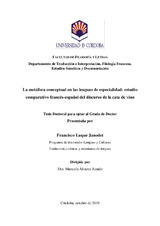Mostrar el registro sencillo del ítem
La metáfora conceptual en las lenguas de especialidad: estudio comparativo francés-español del discurso de la cata de vino
| dc.contributor.advisor | Álvarez Jurado, Manuela | |
| dc.contributor.author | Luque Janodet, Francisco | |
| dc.date.accessioned | 2020-01-10T11:53:40Z | |
| dc.date.available | 2020-01-10T11:53:40Z | |
| dc.date.issued | 2020 | |
| dc.identifier.uri | http://hdl.handle.net/10396/19266 | |
| dc.description.abstract | En el presente estudio se analiza el léxico de la cata de vino en el par de lenguas francés-español desde una perspectiva tripartita, contemplando los estudios en traducción vitivinícola, en terminología y en lingüística cognitiva. Asimismo, surge como respuesta al potencial económico del sector agroalimentario en España y en la comunidad autónoma de Andalucía, un hecho que se refleja en las numerosas Denominaciones de Origen que amparan varios de sus productos tradicionales, como el jamón ibérico, el vino o el aceite de oliva. Por este motivo, se toma como objeto de estudio del discurso de la cata de los vinos generosos andaluces amparados por las denominaciones de origen Jerez-Xérès-Sherry, Málaga y Montilla-Moriles. Esta tesis doctoral, que se organiza en torno a cuatro capítulos, parte del diseño y compilación de un corpus textual bilingüe francés-español conformado por notas de cata. Por ello, en primer lugar, se han delimitado las principales características y factores que intervienen en una sesión de cata de vino. Posteriormente, se aborda la naturaleza de las lenguas de especialidad y se procede a su caracterización. Tras esto, se trata de definir y delimitar los principales rasgos de la metáfora, tras lo cual se analiza su función en los discursos especializados y su relación con la cultura. A partir de ahí, se procede a caracterizar el discurso de la cata de vino como una lengua de especialidad y la nota de cata como un texto especializado y un género textual enológico. A continuación, tras la compilación del corpus de notas de cata, se realiza un análisis comparativo de las distintas expresiones metafóricas y se determinan las metáforas conceptuales subyacentes en la descripción de este tipo de vino en las fases de su cata. Seguidamente, se extraen y analizan 139 términos en fichas terminológicas y se propone una traducción en el par de idiomas de trabajo. Este trabajo permite avanzar en los estudios de traducción vitivinícola y ofrece, además, una herramienta al traductor profesional y al alumnado de grado y postgrado. | es_ES |
| dc.description.abstract | In the present study, the lexicon of wine tasting in the French-Spanish language pair is analyzed from a tripartite approach, considering studies in wine translation, terminology and cognitive linguistics. Furthermore, it emerges in response to the economic potential of the agri-food sector in Spain and in the autonomous community of Andalucia. This fact is reflected in great number of designations of origin that protect several traditional products, such as Iberian ham, wine or olive oil. For these reasons, the discourse of Andalusian generous wines tasting protected by the designations of origin Jerez-Xérès-Sherry, Málaga and Montilla- Moriles is taken as object of study. This doctoral thesis is organized around four chapters. It sets out from the design and compilation of a French-Spanish bilingual textual corpus of wine tasting notes. First, the main characteristics and factors involved in a wine tasting session have been delimited. Thereafter, it is intended to study and characterize the specialized languages. Afterwards, the definition and delimitation of the main characteristics of metaphor are addressed. Thus, the functions of conceptual metaphor in specialized discourses and its relationship with culture are analyzed. From there on, this dissertation addresses the nature of the discourse of wine tasting as a specialized language and the wine tasting note as a specialized text and an oenological textual genre. Then, after the compilation of a textual comparable corpus of wine tasting notes, a comparative analysis of the different metaphorical expressions is performed and the conceptual metaphors underlying the description of this type of wine in the phases of its tasting are determined. Next, 139 terms are extracted from the corpus and analyzed. A translation of these terms in the working language pair is proposed after a traductological analyse. This work allows to make further progress in wine translation studies and also offers a tool to the professional translator and graduate and postgraduate students. | es_ES |
| dc.format.mimetype | application/pdf | es_ES |
| dc.language.iso | spa | es_ES |
| dc.publisher | Universidad de Córdoba, UCOPress | es_ES |
| dc.rights | https://creativecommons.org/licenses/by-nc-nd/4.0/ | es_ES |
| dc.subject | Cata de vino | es_ES |
| dc.subject | Metáfora conceptual | es_ES |
| dc.subject | Creación léxica | es_ES |
| dc.subject | Lingüística cognitiva | es_ES |
| dc.subject | Terminología | es_ES |
| dc.subject | Traducción agroalimentaria | es_ES |
| dc.subject | Lenguas de especialidad | es_ES |
| dc.subject | Wine tasting | es_ES |
| dc.subject | Conceptual metaphor | es_ES |
| dc.subject | Lexical creation | es_ES |
| dc.subject | Cognitive linguistics | es_ES |
| dc.subject | Terminology | es_ES |
| dc.subject | Agri-food translation | es_ES |
| dc.subject | Specialized languages | es_ES |
| dc.title | La metáfora conceptual en las lenguas de especialidad: estudio comparativo francés-español del discurso de la cata de vino | es_ES |
| dc.type | info:eu-repo/semantics/doctoralThesis | es_ES |
| dc.rights.accessRights | info:eu-repo/semantics/openAccess | es_ES |

